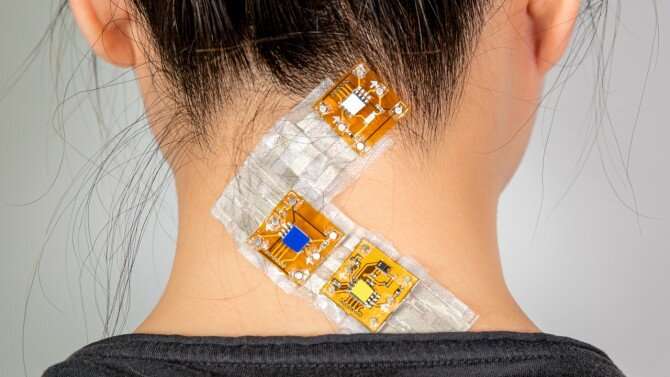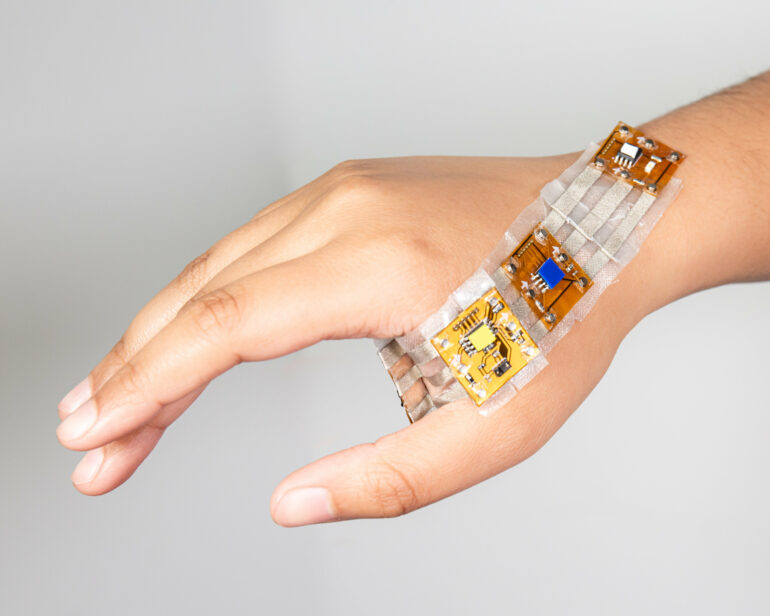Personal computing has gotten smaller and more intimate over the years—from the desktop computer to the laptop, to smartphones and tablets, to smart watches and smart glasses.
But the next generation of wearable computing technology—for health and wellness, social interaction and myriad other applications—will be even closer to the wearer than a watch or glasses: It will be affixed to the skin.
On-skin interfaces—sometimes known as “smart tattoos”—have the potential to outperform the sensing capabilities of current wearable technologies, but combining comfort and durability has proven challenging. Now, members of Cornell’s Hybrid Body Lab have come up with a reliable, skin-tight interface that’s easy to attach and detach, and can be used for a variety of purposes—from health monitoring to fashion.
Doctoral student and lab member Pin-Sung Ku is lead author of “SkinKit: Construction Kit for On-Skin Interface Prototyping,” which was presented in September at UbiComp ’22, the Association for Computing Machinery’s international joint conference on pervasive and ubiquitous computing.
“We’ve been working on this for years, and I think we’ve finally figured out a lot of the technical challenges,” said Cindy (Hsin-Liu) Kao, assistant professor of human centered design in the College of Human Ecology, and the study’s senior author. “We wanted to create a modular approach to smart tattoos, to make them as straightforward as building Legos.”
SkinKit—a plug-and-play system that aims to “lower the floor for entry” to on-skin interfaces, Kao said, for those with little or no technical expertise—is the product of countless hours of development, testing and redevelopment, she said.
Kao’s lab is also very conscious of cultural differences generally, and she thinks it’s important to bring these devices to diverse populations.
“People from different cultures, backgrounds and ethnicities can have very different perceptions toward these devices,” she said. “We felt it’s actually very important to let more people have a voice in saying what they want these smart tattoos to do.”

The SkinKit wearable sensing interface, developed in the Hybrid Body Lab, can be used for health and wellness, personal safety, as assistive technology and for athletic training, among many applications. © Hybrid Body Lab/Provided
Fabrication is done with temporary tattoo paper, silicone textile stabilizer and water, creating a multi-layer thin film structure the group calls “skin cloth.” The layered material can be cut into desired shapes—for their study, the researchers used three-quarter-inch squares, with male-female cutting lines so the pieces can be tessellated (joined together)—and fitted with miniaturized flexible printed circuit board modules to perform a range of tasks.
“The starting point was to find a suitable form factor, and then to make it scalable,” Ku said. “And the way we scale it is through the tessellation pattern. So then the user can design a circuit and then customize the layout by putting multiple modules together.”
One of the benefits of their design, Ku said, is the reusability component.
“The wearer can easily attach them together and also detach them,” he said. “Let’s say that today you want to use one of the sensors for certain purposes, but tomorrow you want it for something different. You can easily just detach them and reuse some of the modules to make a new device in minutes.”
To test SkinKit, the researchers first recruited nine participants with both STEM and design backgrounds to build and wear the devices. Their input from the 90-minute workshop helped inform further modifications, which the group performed before conducting a larger, two-day study involving 25 participants with both STEM and design backgrounds.
Devices designed by the 25 study participants addressed: health and wellness, including temperature sensors to detect fever due to COVID-19; personal safety, including a device that would help the wearer maintain social distance during the pandemic; notification, including an arm-worn device that a runner could wear that would vibrate when a vehicle was near; and assistive technology, such as a wrist-worn sensor for the blind that would vibrate when the wearer was about to bump into an object.
Other applications were for social, fashion and athletic training purposes.
Kao said members of her lab, including Ku, took part in the 4-H Career Explorations Conference over the summer, and had approximately 10 middle-schoolers from upstate New York build their own SkinKit devices.
“I think it just shows us a lot of potential for STEM learning, and especially to be able to engage people who maybe originally wouldn’t have interest in STEM,” Kao said. “But by combining it with body art and fashion, I think there’s a lot of potential for it to engage the next generation and broader populations to explore the future of smart tattoos.”
More information:
Pin-Sung Ku et al, SkinKit, Proceedings of the ACM on Interactive, Mobile, Wearable and Ubiquitous Technologies (2021). DOI: 10.1145/3494989
Provided by
Cornell University
Citation:
New ‘smart tattoos’ tackle tech challenges of on-skin computing (2022, November 3)



